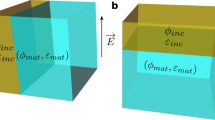Abstract
Based on the effective medium theory, we calculated the complex effective permittivity of the twophase composite medium, consisting of circular inclusions embedded in a surrounding host. Results show that the maximum dielectric loss of the composite medium can be obtained by tuning the dielectric properties of the inclusion. This was confirmed by the results in literature. The local high temperature, as a consequence of the local electric field enhancement phenomenon, is the main reason that microwave heating can lead to a dramatic increase in the chemical reaction rate.
Similar content being viewed by others
References
Lidström P, Tierney J, Wathey B, et al. Microwave-assisted organic synthesis - a review. Tetrahedron, 2001, 57(45): 9225–9283
Loupy A, Monteux D, Petit A, et al. Towards the rehabilitation of the Leuckart reductive amination reaction using microwave technology. Tetrahedron Letters, 1996, 37(45): 8177–8180
Dandia A, Saha M, Taneja H. Synthesis of fluorinated ethyl 4-aryl-6-methyl-1,2,3,4-tetrahydropyrimidin-2-one/thione-5-carboxylates under microwave irradiation. Journal of Fluorine Chemistry, 1998, 90(1): 17–21
Stadler A, Kappe C O. High-speed couplings and cleavages in microwave-heated, solid-phase reactions at high temperatures. European Journal of Organic Chemistry, 2001, 2001(5): 919–925
Gedye R, Smith F, Westaway K, et al. The use of microwave ovens for rapid organic synthesis. Tetrahedron Letters, 1986, 27(3): 279–282
Li J D, Shen H, Chen M. Theory of Dielectric Media. Beijing: Science Press, 2003 (in Chinese)
Stadler A, Kappe C O. Microwave-mediated Biginelli reactions revisited. On the nature of rate and yield enhancements. Journal of the Chemical Society. Perkin Transactions, 2000, 2: 1363–1368
Wroe R, Rowley A T. Evidence for a non-thermal microwave effect in the sintering of partially stabilized zirconia. Journal of Materials Science, 1996, 31(8): 2019–2026
Huang M, Peng J H, Yang J J, et al. A new equation for the description of the dielectric losses under microwave irradiation. Journal of Physics D: Applied Physics, 2006, 39(10): 2255–2258
Xia Z, Huang M, Wu Y F, et al. Modelling the universal dielectric response in heterogeneous materials using 3-D RC networks. Acta Physica Sinica, 2008, 57(2): 957–961 (in Chinese)
Niu H, Peng J H, Wei C, et al. Research on microwave-absorbing characteristics of mixtures of different proportions of carbonaceous reducer and zinc-kiln slag in microwave field. Journal of Sichuan University (Engineering Science Edition), 2007, 39(6): 96–101 (in Chinese)
Huang M Y, Peng J H, Huang M, et al. Microwave-absorbing characteristics of mixtures about different proportions of carbonaceous reducer and ilmenite in microwave field. The Chinese Journal of Nonferrous Metals, 2007, 17(3): 467–480 (in Chinese)
Huang M Y, Peng J H, Lei Y, et al. The temperature rise behavior and microwave-absorbing characteristics of ilmenite concentrate in microwave field. Journal of Sichuan University (Engineering Science Edition), 2007, 39(2): 111–115 (in Chinese)
Mejdoubi A, Brosseau C. Intrinsic resonant behavior of metamaterials by finite element calculations. Physical Review B, 2006, 74(16): 165424–165432
Sareni B, Krähenbühl L, Beroual A. Complex effective permittivity of a lossy composite material. Journal of Applied Physics, 1996, 80 (8): 4560–4565
Jylhä L, Sihvola A. Equation for the effective permittivity of particle-filled composites for material design applications. Journal of Physics D: Applied Physics, 2007, 40(16): 4966–4973
Author information
Authors and Affiliations
Corresponding author
Rights and permissions
About this article
Cite this article
Peng, Jh., Yang, Jj., Huang, M. et al. Simulation and analysis of the effective permittivity for two-phase composite medium. Front. Mater. Sci. China 3, 38–43 (2009). https://doi.org/10.1007/s11706-009-0015-2
Received:
Accepted:
Published:
Issue Date:
DOI: https://doi.org/10.1007/s11706-009-0015-2



